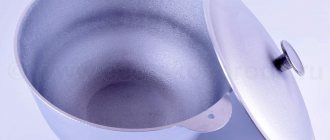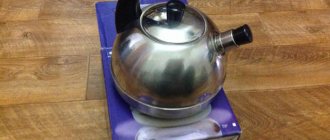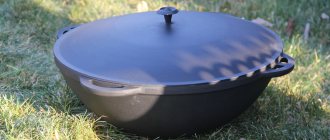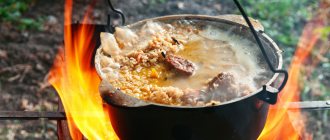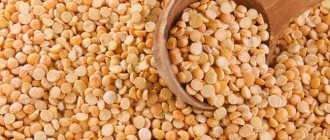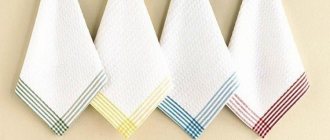Table Of Contents
- How to properly fire a cauldron for the first time
- New cast iron cauldron - how to prepare for use?
- What methods can you use to properly heat a cast iron cauldron?
- Calcination with table salt
- Processing a cauldron with oil
- Processing a cauldron in the oven
- Why are cauldrons heated?
- Where can I prepare a cauldron for first use?
- Heating a cauldron on a fire
- Heating a cauldron at home
- How to heat a cauldron from rust?
- Removing rust from a cast iron cauldron
- Features of preparing an aluminum cauldron before using it for the first time
- How to check a heated cauldron?
- Rust from the cauldron
- Soot and carbon deposits from the cauldron
- Fat from a cauldron
- How to properly clean a cast iron cauldron from burning?
- Preventing carbon deposits on a cast iron cauldron when cooking on the stove
- Further care of the cauldron
- How to wash a cast iron cauldron?
- The process of cleaning an aluminum cauldron
- Restoring the non-stick layer after cleaning the cauldron
- Tips for restoring the non-stick layer
- Conclusion
After purchasing a new cast iron cauldron, you need to prepare it. In this article you will learn how to fire a new cast iron cauldron correctly and what is needed for this. This is important for preparing food so that food does not stick and the washing process goes smoothly.
What methods can you use to properly heat a cast iron cauldron?
Cast iron cauldrons have thick walls, but require care. An accidental fall leads to cracks, because the alloy is quite fragile. There are different methods for cleaning and preparing a cauldron for the first use ; you can choose between an open fire and processing at home.
Calcination with table salt
Manufacturers are working on the quality of the coating, increasing its resistance to mechanical stress. For example, the Protectal Plus coating uses the Fissler brand. A chemical reaction creates aluminum oxide, then a non-stick layer is placed. This allows you to use paddles made of
This technique will help you get started and involves the following:
- installation of the structure on a slab with a maximum size;
- filling the bowl within 3 cm with coarse salt, distributing the mass throughout the bowl;
- turning on the stove until the smell of smoke appears;
- hold for up to 30 minutes with the stove on;
- The salt needs to be stirred periodically. Absorbing factory grease, it will darken;
- turn off the stove and container and leave it on the stove to cool;
- Throw away contaminated salt.
All that remains is to wash the inside of the structure. There will be enough laundry soap, mustard powder and warm water.
Processing a cauldron with oil
How to prepare a cauldron for the first use using oil? You need 300-700 ml of oil to cover the bottom from 2 cm. The oil should touch all the walls, the structure will turn over. Low fire is selected to avoid fires and strong smoke production. It is worth keeping a fire extinguisher nearby, the time depends on the size of the cauldron, on average it is 40-50 minutes. Next, the residues are drained and the bottom is cleaned with a paper napkin. This oil cannot be used for food.
Processing a cauldron in the oven
Preparing the cauldron for the first use is permitted using an oven. You need to keep the cauldron inside for an hour at 180 degrees. A bluish smoke will come out of the cracks, so you need to wait until the smoke emission stops. From time to time it is worth opening the oven slightly, and taking out the cauldron only after it has cooled down. Next, it is washed with soap.
How to form a non-stick coating
Preparation for first use involves not only eliminating machine oil odors and other impurities. In order for new cookware to function smoothly, it is imperative to make a non-stick coating.
This is done like this:
- The cauldron must be dry. Lubricate it generously with vegetable oil, without skimping.
- Place the coated dishes on paper towels. Use another towel or napkins to remove oil stains.
- Briefly turn the container upside down so that the oil drains. Then move it to the oven, accelerated to a temperature of 180. It is recommended to lay foil on the bottom of the oven so that the dripping oil does not fall on the oven cover.
- Keep the dishes in the oven for at least three hours. This time is needed for the oil to fry and turn into a thin but durable film that will protect the cauldron from burning.
Where can I prepare a cauldron for first use?
Both home and outdoor conditions are suitable for the process. But it is worth considering the presence of a considerable amount of smoke.
Heating a cauldron on a fire
Calcination at the stake is the best option. Dry firing is performed over a fire; after the grease burns out, a lighter grayish tint of the coating appears. You need to remove the cauldron from the snow or grass after it has acquired a uniform color. It must be washed and calcined again before use with periodic treatment with vegetable oil.
Heating a cauldron at home
At home, an oven or stove is suitable; the goal is to heat the structure evenly and for a long time. It can take up to 60 minutes to get to work, and smoke will be coming out the entire time, so it’s a good idea to open all the windows and reassure your neighbors.
Types of calcination
Firing a cast iron cauldron before the first cooking is simply necessary; there are several types of calcination; you can choose the most suitable one and prepare your kitchen utensils.
Calcination with table salt
Salt is poured onto the bottom of the vessel and placed on a hot stove or fire. The seasoning will absorb all the excess liquid and remaining oil, after which the cauldron will become completely suitable for preparing food. Together with salt, the utensils will smoke and smell less; immediately after they darken, turn off the stove and allow the cast iron to cool.
The seasoning will absorb all the excess liquid and remaining oil.
Oil treatment
After the standard calcination procedure, it is important to go through it again, but using oil. To do this, pour oil into the pan; if it is still hot, then use a potholder or a thick towel. Turn the cauldron so that all the walls are covered with oil, then place the container back on the open fire for ten minutes and wait until bluish smoke appears. To better lubricate the walls, take an ordinary long wooden spatula, which is wrapped in paper, and use it to distribute the oil along the walls of the kitchen utensil. This way it will penetrate into all the pores of the heated vessel and form a thin protective coating on the surface. Thanks to it, food will not burn to the bottom of the cauldron. After this procedure, all remaining contents are drained and the bottom of the container is wiped with a paper napkin.
Processing a cauldron in the oven
For this method, the oven is thoroughly heated to 180-200 degrees, the cauldron is washed with warm water without soap. Then place the dishes on a baking sheet and wait until dark smoke comes out of the cabinet doors. Allow the kitchen utensils to cool and wash with warm water, then dry with a towel.
Roasting over an open fire
Another method of effectively firing cast iron is firing over a fire. They hang the cauldron over the fire and wait until all the rusty spots disappear and the acrid gray smoke stops pouring out of the equipment. Kitchen utensils will begin to change color and become suitable for cooking.
How to heat a cauldron from rust?
To remove rust, the product is calcined, then it is allowed to use sandpaper with different levels of abrasive. Calcination makes cleaning easier. After removal, a layer of oil is created and baked at 250 degrees for an hour.
Removing rust from a cast iron cauldron
For cast iron, chemical compositions from the store with further oil firing are suitable. You can also soak the product in water with a high vinegar content for 30 minutes. Next, calcination and creation of an oil film with firing are carried out.
Why calcinate the cauldron
Before the first use, it is enough to wash any other dishes with detergent and they can already be used. However, a new cast iron cauldron should be fired before use.
The fact is that in the manufacture of cast iron cookware, a special technical lubricant is used. It is used to process the mold for pouring the product for easy removal of the finished dishes. It protects cast iron products from corrosion during storage and transportation.
However, during cooking, such grease mixes with food and gives it an unpleasant aroma and taste. You cannot eat such food. Therefore, before the first use, such utensils are calcined to completely remove traces of technical lubricant.
There are several ways to fire a cast iron cauldron. All of them are quite simple, you just need to strictly follow the instructions and observe safety precautions.
How to check a heated cauldron?
How to fire a new cast iron cauldron and check the correctness of firing? You need to get a color without dullness, saturated. If it is uneven, the light will not be reflected correctly. There should be no rust. To check, moisten a napkin with oil and wipe the bottom and edges with it. There shouldn't be any traces. If there is a brownish coating, oil firing is repeated. Aluminum can only be checked by the absence of carbon deposits on the walls.
Rust from the cauldron
Proper removal will extend the service life, avoid damage and other defects.
Soot and carbon deposits from the cauldron
If you can’t wash it with hot water, add a little baking soda. In nature, it is good to use river sand. Hot water removes food residues well, but removing carbon deposits with a fork or knife is unacceptable.
Fat from a cauldron
Eliminated with hot water, river sand, using boiling with the addition of a small amount of ordinary soda.
Using oil for calcination
After completely burning out the harmful oil, another film of oil needs to be formed on the walls of the new cauldron. Only vegetable oil is already used.
Read also: Power bank is swollen
The volume of your cauldron matters here. Usually a minimum of 500 – 1000 ml of oil is required to cleanse. It is poured into a cauldron. It is placed on low heat for 30 minutes. During such boiling, the cauldron must be periodically tilted so that its walls are completely covered with the required film.
Then the stove turns off. The oil is cooling. It is drained from the cauldron. The cauldron itself should be cleaned with warm water. Detergents must not be used. The dishes are wiped dry. You need to walk along its internal surfaces with a rag previously soaked in natural oil. Your new aluminum cauldron is now ready for use. Please note that if not handled properly, the oil may ignite.
Caring for an aluminum cauldron is quite troublesome than preparing it for use. Its protective film can be easily removed due to harsh cleaning devices: washcloths and brushes.
And if you want to purchase an aluminum product that will largely replace the thick-walled cast iron Tatar analogue, the walls of this product must be at least 1 cm thick.
Further care of the cauldron
It is important to dry the product with a towel and dry it, so all remaining moisture will evaporate. The container can then be removed for storage. For long-term storage, wrap with cloth or parchment. The product should be placed on its side and washed without aggressive chemicals.
How to wash a cast iron cauldron?
Important! Cast iron should not be scratched with sharp objects, but the use of a metal brush, soda and sand is allowed.
Fat-dissolving mixtures are undesirable; they will remove the natural film that prevents burning.
The process of cleaning an aluminum cauldron
Formulations that dissolve fat are acceptable; only products containing oxalic acid are not suitable. They spoil the color of the metal. Abrasives and metal brushes are suitable; soaking or using a dishwasher will not cause harm.
Features of preparing an aluminum cauldron before using it for the first time
Cast duralumin is inferior in physical properties to traditional cast iron. Utensils become unusable faster and do not retain heat well. But aluminum has an undeniable advantage - light weight. It is difficult for a petite housewife to hold a cast iron cauldron with food; it is better to give her an aluminum one.
The second plus is that duralumin can be placed in the dishwasher.
The process of preparing aluminum casting for cooking is not much different from firing cast iron. Main differences.
- Aluminum cannot be overheated; the bottom will become rounded and the walls will become oval.
- It is better to use damp wood for a fire; they have a lower combustion temperature.
- Aluminum cookware requires 1/3 less time to prepare.
- It is not recommended to do dry calcination; you need to use salt or oil.
- Temperature shock (sharp temperature contrast) is undesirable for duralumin.
Once the firing is complete, free aluminum will not get into the food and will not enter into a chemical reaction with any product during cooking.
Restoring the non-stick layer after cleaning the cauldron
Treatment will allow you to return the usual properties of the dishes. After thorough cleaning, it will lose its characteristics and food will stick and burn. The usual color is lost.
Tips for restoring the non-stick layer
Washing with warm water, wiping dry, coating with salt and baking will help restore properties. If this has already been done, all that remains is to apply sunflower oil to the inside.
Correct calcination
Calcination and cleaning with salt is not recommended for use at home in the kitchen or indoors in general. Hot oil and salt can lead to burns, damage to furniture, fire, and acrid smoke will permeate your entire apartment.
It would be correct to transfer these procedures to the open air.
Let's clean it first
Cast iron has a porous surface and you will not be able to wash such dishes clean. Rust in hard-to-reach pores adds complexity. It will not allow a film to form in this place. We need to find a way to clean it properly.
Traditionally, cast iron cauldrons are cleaned with salt.
So, you already have a washed cauldron, there is a fireplace for the cauldron, firewood, 1-2 kg of table salt per 10 liters of cauldron volume and a convenient iron slotted spoon.
The process is slow and will take 2 hours of your time.
Let's get started:
- Place salt in a cold cauldron.
- Light a fire.
- Keep the heat below medium. Stir the salt occasionally.
- When the salt turns light brown, remove the heat from under the cauldron and let the cauldron and the salt cool.
- Salt is good for nothing after cleaning - throw it away.
- The surface of the cauldron is cleaned with dry paper towels or dry napkins.
Protect your skin and eyes from hot salt.
Now the surface is cleaned and has no protection. You need to immediately proceed to firing, otherwise the dishes will quickly rust.
Firing in oil
Firing a cauldron with oil is sometimes called “blueing,” but this is incorrect. No iron oxides are formed here and a smooth film of oil burnt to the cast iron is created.
Don’t be alarmed by what’s burnt: you won’t notice it in the dish.
For roasting, either vegetable oil (sesame, flaxseed, sunflower) or animal fat (pork, beef or lamb) is used.
You will need 0.1-0.3 liters of oil per 10 liters of cauldron volume. A fireplace for the cauldron, some firewood and the right slotted spoon will also be required.
Let's start forming the film:
The firing itself will take 20-30 minutes. And will require your active participation
- The cauldron should be dry inside. Be sure to check and, if necessary, dry with paper towels or dry wipes.
- Pour oil into a cold cauldron.
- Light a fire. The heat should be medium.
- Using a slotted spoon or tilting the cauldron, coat the entire inside surface with oil. Important: Try not to splash oil on the fire.
- Keep an eye on the walls and periodically pour oil on them when they seem to be drying out. I see.
- After calcination is complete, drain the oil. It needs to be thrown away.
- Let the cauldron cool, remove it from the heat.
- Wipe the surface of the cauldron with paper towels to absorb all unnecessary oil.
In a wiped-clean cauldron, the first thing to do is boil water. If the water does not turn out cloudy, the dishes can be safely used for dishes.
How to bake in the kitchen
We have an extremely negative attitude towards carrying out these procedures at home.
This is due to a nasty smell throughout the entire apartment, a fire hazard, and the threat of burns.
We believe there is no reason to justify firing cast iron cookware in an apartment.
But if you are determined, we have some tips on how to reduce the harm:
- Open all windows. A draft will only be a plus.
- When cleaning, use one-third less salt, but stir more often.
- When firing on a burner, add salt to the oil 1:1, this will reduce smoke.
- Use the oven to bake. More on this below.
If you bake in the oven:
- Heat the oven to 180-200 degrees.
- Pour 10-25 grams of oil into a cast iron pan. Apply oil with a brush to the entire inner surface.
- Cover the top of the dish with foil. This will keep your oven free of oil.
- The dishes are kept for 40 minutes - 1.5 hours.
- It will take 3-5 approaches. Applying oil and keeping in a preheated oven.
Why fire a new cauldron?
Utensils leave the factory assembly line in salable condition, but you cannot cook food in them. Cauldrons are made by casting; the molds are lubricated with a special mixture so that the hot metal does not stick. Before shipping, the dishes are processed again and covered with a protective layer that protects cast iron and porous duralumin from corrosion damage.
Proper preparation of dishes for use and their processing will help to avoid many problems with them in the future.
The lubricant is not food grade, so you need to get rid of it after purchase. This cannot be done with soap, a brush and hot water. Porous metal deeply absorbs coating components.
Important! Do not wash porous castings with aggressive detergents. The chemical will sit deep in the pores and will be released during the cooking process. The food will turn out tasteless.
Care instructions
- For long-term storage, the cauldron is wrapped in parchment or cloth.
- It is better to store dishes on their side so that condensation does not form under the bottom;
- After each preparation, the dishes are washed without using aggressive chemicals.
On hot cast iron walls, the oil should enter the pores of the metal and remain there in the form of a thin film.
Important! It is better to remove dirt from cast iron with soda or dry mustard. An old ready-made one will also work. Coarse salt is used instead of abrasive. If the food is burnt, fill the cauldron with WARM water, add a little soda and salt (1 tablespoon per liter of water).
Over time, the protective oil layer on the metal is destroyed. The dishes have to be fired again. It is recommended to do this at least once a year.
On aluminum, non-stick protection is restored if food burns severely.
Despite the wide variety of frying pans, saucepans made of ceramics, stainless alloys, good old casting is still in fashion. In order not to have to prepare dishes for cooking, you can purchase a cast iron or aluminum cauldron with enamel, ceramic or non-stick coating.
Pilaf in such a container will turn out excellent!


